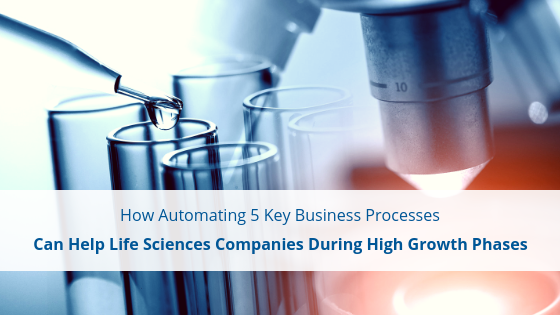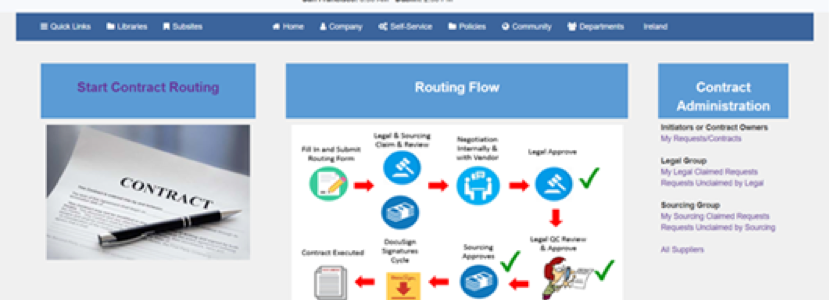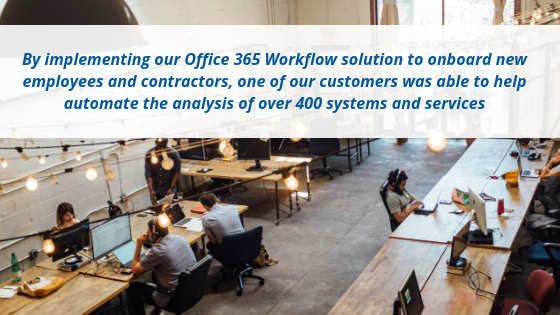Office 365
How Automating 5 Key Business Processes Can Help Life Sciences Companies During High Growth Phases


Life sciences companies experience various degrees of growth based on their evolution through discovery and R&D efforts leading into clinical trials. As a company’s target drug receives positive feedback through initial clinical trials, they can experience 50% to 100% growth in one year. If they are granted approval, they also can experience growth as they add on more personnel to sales and operations.
This growth is exciting but results in insecure collaboration and significant challenges to operational efficiency.
As a life science company grows, what was once an efficient process quickly gets out of control and becomes an operational burden. Manual processes that were once simple and easy become cumbersome and inefficient. This may be simple HR processes like vacation requests or expense management, or it may be more complicated solutions such as employee reviews, contract management, or the onboarding of new employees.
Navigating the ups and downs of growth phases is successful only if your organization adopts the proper processes and technology to support its day-to-day operations.
Defined and automated solutions that can handle basic and complicated operational tasks – and automatically scale and retract as appropriate – will enable your organization to focus on developing and moving drugs through the FDA approval process.
In this blog post, we’ll explore five key areas where business processes automation can make a material difference, based on our work with 70+ life sciences organizations – from nimble start-ups to publicly-traded enterprises.
1.) Human Resources
We find many life sciences companies use 3rd party Human Resource (HR) providers/tools, such as ADP, that allow them to automate some business processes. Other companies use SaaS solutions for HR workflows that, depending on the solution, have some capability to automate processes.
Whether you have a separate HR solution or not, we have found that the tools in Office 365 can easily be used to automate and simplify many HR processes. The best part — you can implement these solutions at a relatively low cost without requiring any additional investment in software.
Here are some examples of how we’ve automated HR processes in Office 365 for our customers:
- Vacation Request and Carry Over
- Tuition Reimbursement
- Review Process
- Timesheet Tracking
- Employee Training and Tracking
These streamlined and automated processes save HR and your users a significant amount of time. Instead of managing your review process via emails and multiple versions of a review document, an automated solution ensures all individuals involved in a particular review are notified, their responses are tracked, and, if you have multiple managers submitting data on one review, and all responses are automatically tallied into one final review.
2.) Contract Management
A Confidential Disclosure Agreement (CDA) is one of the most widely used agreements in the life sciences sector. Although this is a simple agreement to execute, with the volume of CDA’s sent to partners, vendors, and contractors, finding and managing these documents can quickly get out of control.
Beyond CDA documents, contracts also need to be maintained for all your key relationships. These contracts need to be organized, searchable, and easily tracked for renewals. You also need to ensure proper rules are in place to approve and process contracts efficiently.
Timlin has built several solutions to manage the entire contract management process at life sciences firms. Historically we accomplished these solutions using 3rd party workflow and forms solutions. Recently, we have seen that the evolution of Microsoft Flow and Power Apps has allowed us to build these solutions using the tools and applications within Office 365, removing the need for our customers to purchase 3rd party solutions. Here’s an example below:

With the core document management and publishing capabilities in SharePoint Online, combined with the forms and workflow capabilities of Flow and Power Apps, and integration of electronic signatures, life science organizations can have a powerful contract management solution.
3.) Onboarding and Offboarding Employees & Contractors
Although technically an HR process, the critical nature of efficiently and securely onboarding and offboarding employees and contractors has proven to be a huge benefit to our customers. When you’re hiring 15 people a week, it’s essential to have a pre-defined and automated process to onboard everyone, so they add value and perform their tasks as soon as possible.
Life science organizations should consider automating the entire onboarding process. The process would begin before the new employee or contractor has set foot in the door.
For example, we can build a workflow that will add a new record into your Active Directory (AD) when an offer is accepted, and then the flow triggers based on the employee start date to enable access to the appropriate systems on that date. Our onboarding solutions can integrate with your HR, finance, and other systems as required to ensure all required steps are handled based on pre-defined rules. One of our customers was able to help automate the analysis of over 400 systems and services with this solution.
In addition to onboarding new employees and contractors efficiently, it is equally important to shut down all access once someone leaves the organization.
Data and intellectual property protection are incredibly important for life science organizations to maintain. Not only does access need to be terminated, but these actions also need to be logged, especially for public companies who are under SOX compliance. We have delivered automated offboarding solutions at several organizations, and have built offboarding PowerShell scripts that:
- Capture last login date
- Last password set date
- Current AD security group membership
- Set new password
- Cancel O365 meetings
- Remove from all AD security groups
- Remove manager
- Set default group to “No Access”
- Move user to off boarded OU

4.) Finance
Finance is another key area ripe for automation in life sciences organizations. Imagine implementing expense request approvals and reporting that provide separate approval workflows based on the amount of the expense, requestor, or department.
Another key finance flow that has proven to greatly help finance operations is Purchase Order (PO) approvals and processing. An automated PO process allows users to enter details on a new PO Request, then a workflow is triggered to ensure the correct individual(s) approve the request based on the amount, requesting department or individual.
The workflow would also provide full transparency to the submitter on the status of their request. Lastly, the workflow can integrate with or allow finance to enter the required General Ledger items.
5.) Information Technology
There are two primary areas where automating IT processes make a material difference. First, life science organizations typically follow a specific documentation review and approval process. Imagine if that workflow was built into documentation development using SharePoint? Not only is the process streamlined, but also results in more effective document management and security.
The second area is the trouble ticket resolution. Given the speed at which life sciences organizations operate, uptime is critical. Providing self-service and automated trouble ticketing solutions ensure all IT requests are tracked and managed effectively.
Successful Growth Phases Are Dependent on Strategic and Sustainable Business Automation
When you are in a high-growth phase of your company’s lifespan, it’s critical to ensure business processes are efficient. It may feel stressful most of the time, but it’s a good problem to have. These phases mean you are receiving positive results in your drug development and clinical trials. With the proper levels of process automation, your life science organization will be able to easily and efficiently ride the waves toward FDA approval.
If you’re interested in learning more about the automation services we provide to life sciences organizations, reach out to our team of Office 365 and SharePoint experts here.

